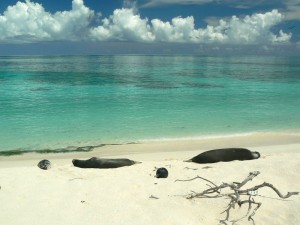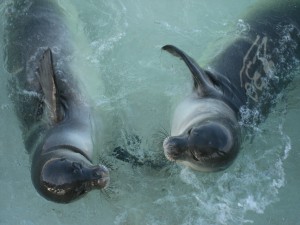Media Watch, Hawaii News Now, 6 August 2011
 NOAA says it plans to euthanize one and possibly two adult male Hawaiian monk seals at Kure Atoll in the Northwestern Hawaiian Islands this month to protect female monk seals and pups.
NOAA says it plans to euthanize one and possibly two adult male Hawaiian monk seals at Kure Atoll in the Northwestern Hawaiian Islands this month to protect female monk seals and pups.
In a news release the Papahanaumokuakea Marine National Monument on Friday said that the male adult seals have been attacking and mortally wounding young female seals and pups at Kure over the last several years.
The news release says, the agencies responsible for management of the Monument are mandated to mitigate potential threats to an endangered species as well as respond to imminent threats and take all specific regulatory actions to aid the recovery of the species. Managers made the decision now due to the severe threat to the population at Kure.
“None of the managing agencies take this action lightly,” said Monument Management Board Chair Dan Polhemus. “The Board is in a very difficult situation with one of the toughest issues we have faced. If we do not take action, we risk additional young female seals being injured or killed by these males, and losing their future potential to reproduce and help increase the decimated monk seal population.” […]
NOAA says it has a five day window to euthanize the seals, the last day being August 10.
Source: NOAA plans to euthanize “rogue” monk seals, Hawaii News Now, 6 August 2011.

 NOAA says it plans to euthanize one and possibly two adult male Hawaiian monk seals at Kure Atoll in the Northwestern Hawaiian Islands this month to protect female monk seals and pups.
NOAA says it plans to euthanize one and possibly two adult male Hawaiian monk seals at Kure Atoll in the Northwestern Hawaiian Islands this month to protect female monk seals and pups.

 More than 30 years after 50 critically endangered
More than 30 years after 50 critically endangered 